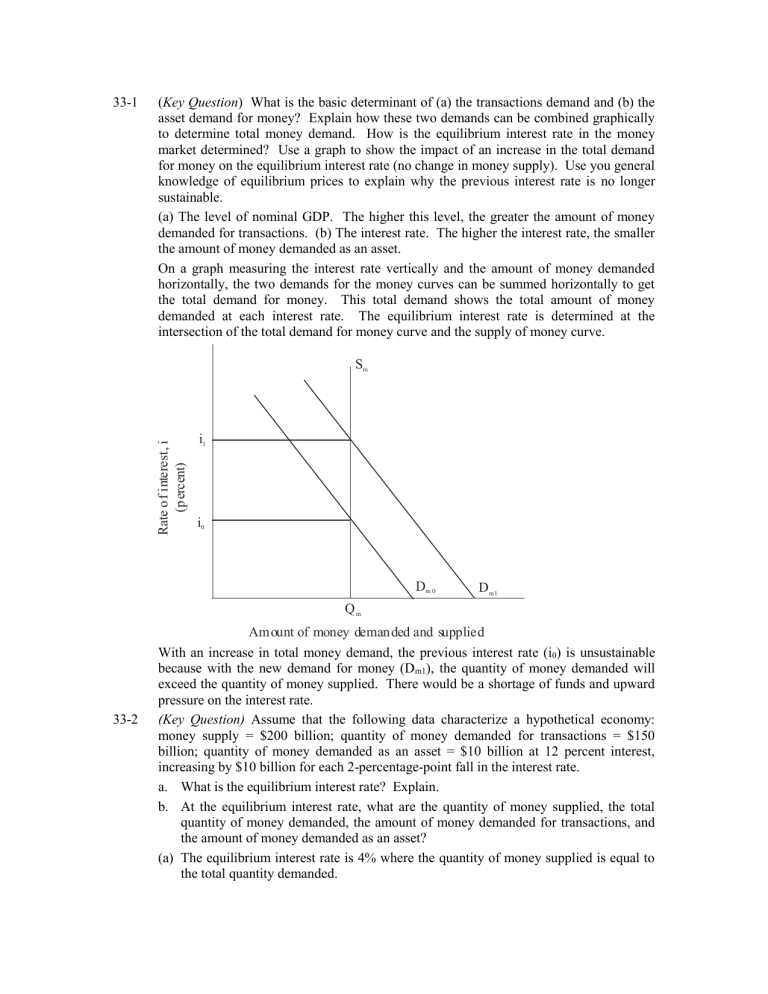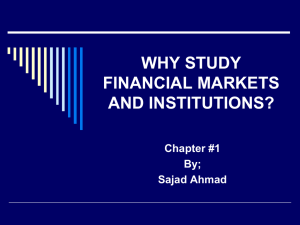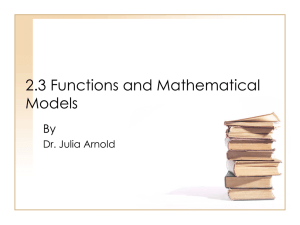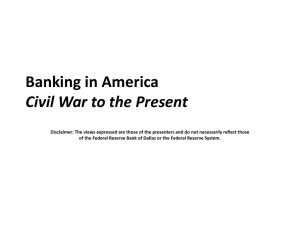Chapter 33 Key Question Solutions

33-1 ( Key Question ) What is the basic determinant of (a) the transactions demand and (b) the asset demand for money? Explain how these two demands can be combined graphically to determine total money demand. How is the equilibrium interest rate in the money market determined? Use a graph to show the impact of an increase in the total demand for money on the equilibrium interest rate (no change in money supply). Use you general knowledge of equilibrium prices to explain why the previous interest rate is no longer sustainable.
(a) The level of nominal GDP. The higher this level, the greater the amount of money demanded for transactions. (b) The interest rate. The higher the interest rate, the smaller the amount of money demanded as an asset.
On a graph measuring the interest rate vertically and the amount of money demanded horizontally, the two demands for the money curves can be summed horizontally to get the total demand for money. This total demand shows the total amount of money demanded at each interest rate. The equilibrium interest rate is determined at the intersection of the total demand for money curve and the supply of money curve.
S m i
1 i
0
D m 0
D m1
Q m
Amount of money deman ded and supplied
With an increase in total money demand, the previous interest rate (i
0
) is unsustainable because with the new demand for money (D m1
), the quantity of money demanded will exceed the quantity of money supplied. There would be a shortage of funds and upward pressure on the interest rate.
33-2 (Key Question) Assume that the following data characterize a hypothetical economy: money supply = $200 billion; quantity of money demanded for transactions = $150 billion; quantity of money demanded as an asset = $10 billion at 12 percent interest, increasing by $10 billion for each 2-percentage-point fall in the interest rate. a. What is the equilibrium interest rate? Explain. b. At the equilibrium interest rate, what are the quantity of money supplied, the total quantity of money demanded, the amount of money demanded for transactions, and the amount of money demanded as an asset?
(a) The equilibrium interest rate is 4% where the quantity of money supplied is equal to the total quantity demanded.
(b) At the equilibrium interest rate the quantity of money supplied is 200 and the asset demand for money is 50, the transactions demand for money is 150 and the total quantity of money demanded is 200.
33-3 ( Key Question ) Suppose a bond with no expiration date has a face value of $10,000 and annually pays a fixed amount on interest of $800. Compute and enter in the spaces provided either the interest rate that the bond would yield to a bond buyer at each of the bond prices listed or the bond price at each of the interest yields shown. What generalization can be drawn from the completed table?
Bond Price
$ 8,000
9,000
10,000
11,000
13,000
Interest rate %
10.0
8.9
8.0
7.3
6.2
Generalization: Bond price and interest rate are inversely related
33-5 ( Key Question ) In the table below you will find consolidated balance sheets for the commercial banking system and the 12 Federal Reserve Banks. Use columns 1 through 3 to indicate how the balance sheets would read after each of transactions a to c is completed. Do not cumulate your answers; that is, analyze each transaction separately, starting in each case from the figures provided. All accounts are in billions of dollars.
CONSOLIDATED BALANCE SHEET: ALL COMMERCIAL BANKS
(1) (2) (3)
Assets:
Reserves
Securities
Loans
Liabilities and net worth:
Checkable deposits
Loans from the Federal
Reserve Banks
$ 33
60
3
60
150
_____
_____
_____
_____
_____
_____
_____
_____
_____
_____
_____
_____
_____
_____
_____
CONSOLIDATED BALANCE SHEET:
TWELVE FEDERAL RESERVE BANKS
(1)
Assets:
Securities
Loans to commercial banks
Liabilities and net worth:
Reserves of commercial banks
Treasury deposits
Federal Reserve Notes
$60
3
$33
3
27
_____
_____
_____
_____
_____
(2)
_____
_____
_____
_____
_____
(3)
_____
_____
_____
_____
_____ a. A decline in the discount rate prompts commercial banks to borrow an additional $1 billion from the Federal Reserve Banks. Show the new balance-sheet figures in column 1 of each table. b. The Federal Reserve Banks sell $3 billion in securities to members of the public, who pay for the bonds with checks. Show the new balance-sheet figures in column 2 of each table. c. The Federal Reserve Banks buy $2 billion of securities from commercial banks.
Show the new balance-sheet figures in column 3 of each table. d. Now review each of the above three transactions, asking yourself these three questions: (1) What change, if any, took place in the money supply as a direct and immediate result of each transaction? (2) What increase or decrease in commercial banks’ reserves took place in each transaction? (3) Assuming a reserve ratio of 20 percent, what change in the money-creating potential of the commercial banking system occurred as a result of each transaction?
(a) Column (1) data, top to bottom: Bank Assets: $34, 60, 60; Liabilities: $150, 4; Fed
Assets: $60, 4; Liabilities: $34, 3, 27.
(b) Column (2) data: Bank Assets: $30, 60, 60; Liabilities: $147, 3; Fed Assets: $57, 3,
30, 3, 27.
(c) Column (3) data (top to bottom): $35; $58; $60; $150; $3; (Fed banks) $62; $3; $35;
$3; $27.
(d) (d1) Money supply (checkable deposits) directly changes only in (b), where it decreases by $3 billion; (d2) See balance sheets; (d3) Money-creating potential of the banking system increases by $5 billion in (a); decreases by $12 billion in (b) (not by
$15 billion—the writing of $3 billion of checks by the public to buy bonds reduces demand deposits by $3 billion, thus freeing $0.6 billion of reserves. Three billion dollars minus $0.6 billion equals $2.4 billion of reduced reserves, and this multiplied by the monetary multiplier of 5 equals $12 billion); and increases by $10 billion in
(c).
33-8 ( Key Question ) Suppose that you are a member of the Board of Governors of the Federal
Reserve System. The economy is experiencing a sharp rise in the inflation rate. What change in the Federal funds rate would you recommend? How would your recommended change get accomplished? What impact would the actions have on the lending ability of
the banking system, the real interest rate, investment spending, aggregate demand, and inflation?
To reduce inflation, the Federal funds rate should be raised. This would be accomplished typically through open-market operations (selling bonds), but could also be achieved with an increase in the reserve ratio or discount rate.
The restrictive monetary policy would reduce the lending ability of the banking system, increase the real interest rate, reduce investment spending, reduce aggregate demand, and reduce inflation.








